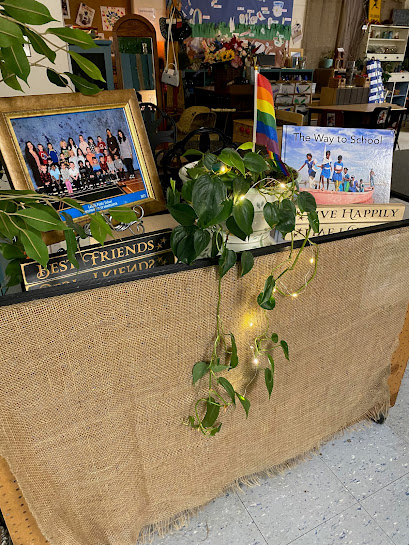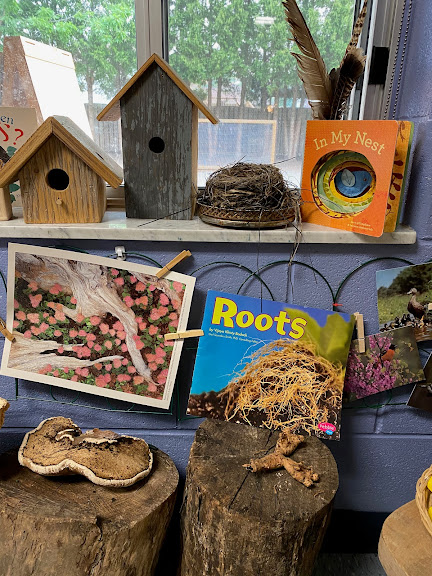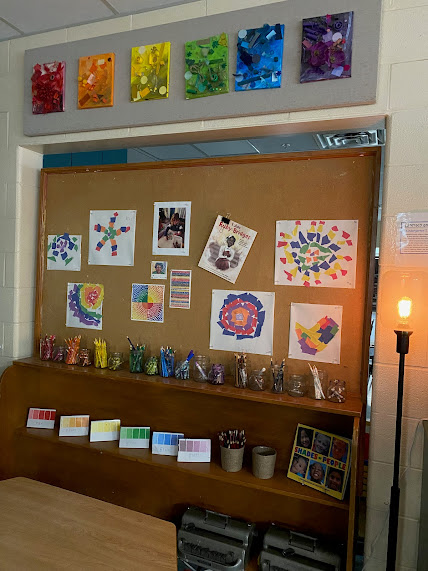I believe in having a fluid, evolved space that continues to change to
better reflect the needs of the children and support heightened
understandings of explorations and inquiries as well as enhanced
abilities in the various domains of learning. We want to support the
whole child in developmentally appropriate experiences and integrate
learning materials from centres in diverse and unconventional ways.
Some of the Reggio principles that have guided my work include:
- children are capable of constructing their own learning
- children form an understanding of themselves and their place in the world through their interactions with others
- children are communicators
- the environment is the third teacher
- the adults in the room are mentors and guides
- there is an emphasis and importance on documenting children's thoughts and experiences
- there are hundreds of languages of children and these are used to explore and communicate ideas and experiences
This
is the door leading to our classroom. I post
information around the door to assure visitors to the space that I
believe in an inclusive environment where all children are respected.
Building relationships with families and helping them learn about and
support growth mindset is a big part of creating a safe and supportive
space for learning. Something about which I've had a
lot of
positive feedback is our 'wish wreath'. Each
September we ask families to write their hopes, wishes, dreams, etc. for
their children's kindergarten experiences on paper ribbons. We weave
each of these onto a grapevine wreath and display it on our door. We
want it to be a symbol of our partnership and collaboration with
families for the year ahead. We also include a photo of our teaching
team and visitors to the room can access our class blog by scanning the
QR code on the door.

Above each child's cubby is a recent photo and painted self-portrait. These change a few times each year (usually a new photo and self-portrait per term) to help show their growth. We like including a real photo to celebrate each child and love how the children use the language of art to represent their perception of self.
Our math area has many things available for children. We include mentor texts, learning props, and documentation to showcase and support our program.
Our drama centre changes based on the interests and requests of the children. At the beginning of the year it is set up as a little 'house' to provide comfort and familiarity to children. We include many real objects for the children to use in their imaginative play; real objects communicate the message to children that they are capable of using these tools and make the context for the imaginary play very real and meaningful. Donations from families and the local community also helps represent the diversity of our population and encourages children to see themselves and their peers reflected in the space. Literacy is interwoven throughout as children can talk on the phone, write on the chalk boards, or follow a recipe when cooking. A variety of scarves encourages children to dress up and create their own costumes and clothing. A large basket of fabric flowers can be turned into different arrangements for the table or inspire other dramatic play (e.g., a flower shop, a farmer's market).
Our building area is the heart of our room and the most popular place to be. Children integrate materials from all around the classroom into their play here. We love the big body play the wooden blocks encourage. Small loose parts (e.g., tile squares, corks, wooden spools) are also included in this area for children to combine with wooden blocks. Pillow are available for incorporation in the creations and photos of local structures are displayed for inspiration.
My favourite center in the classroom is the science area. We are fortunate to have a very large wall of windows on one side of the space. The shelf near the window houses materials that are specific to ongoing inquiries. Loose parts play are a big part of our program as we embrace all things STEAM and love our makerspace. We use many natural and found materials here and always welcome donations from our families. The science area also houses many building materials and the children can freely use these around the room in any area to support their play. Often treasures found outdoors (e.g., pinecones, feathers) and the changing of the seasons inspire inquiries. Invitations for further exploration are sometimes set up on the table in this area. A sensory table integrates imaginative play regarding current interests, here insects and their natural habitat. Children can swap out materials for other small world play (e.g., dinosaurs, fabric flowers).
.jpeg)
The art studio is located in a sunny area of the classroom. You can see that colours and colour mixing are ongoing interests and there is much art that supports this. The materials are aesthetically arranged to be accessible for children and also decorate the space. Materials are organized by colour for ease of accessibility and also to embed math and sorting into the centre.
We are often asked by other educators about how we encourage the children to engage in regular reading and writing in a child-driven space. On the back of our bookshelf are writing clipboards, one per child. We ask children to self-select a piece of writing that they are proud of and display it on their clipboard. These are then brought to a sharing circle where children can discuss their work with others. It's a quick and easy way for us to see which children have (and haven't) engaged in regular writing so we know how to better support their needs. This clipboards can also be brought on nature walks in the yard or community as needed.

















.jpeg)


.jpeg)

.jpeg)
.jpeg)
.jpeg)
.jpeg)
.jpeg)





















.jpeg)
.jpeg)
.jpeg)



.jpeg)


.jpeg)
.jpeg)

Thank you for sharing all of this! As a first year Kindergarten educator i am excited ti see some of our own setup reflected in your space and gained a bunch of new ideas as well!!
ReplyDeleteBeth Lyons
@mrslyonslibrary
What a spectacular classroom!
ReplyDeleteThat is a beautiful classroom set up with all the natural stuff. Thank you for sharing.
ReplyDelete